2 中国科学院大学, 北京 100049;
3 中国科学院地理科学与资源研究所, 中国科学院陆地表层格局与模拟重点实验室, 北京 100101)
全新世作为一个和人类生存繁衍息息相关的地质历史时期,其气候演变过程为现代气候变化的研究提供了重要的参考[1]。东亚季风区作为一个独特的地理区域,在全球气候系统中有着重要的作用[2~3],许多学者对东亚季风区全新世以来的气候演变的研究表明,不同地区的地质记录所揭示的全新世气候的演化过程存在着明显的差异,尤其是全新世适宜期的时间范围存在着较多分歧[3~13]。诸多研究表明东亚季风区全新世最适宜期发生在8.0~3.0cal. ka B.P. 之间[3, 13],但是不同地区也存在着明显的时间差异,尤其在中国东北地区。东北地区由于纬度较高,地处东亚季风边缘,对气候变化较为敏感,已有的孢粉[14]、粒度[15]、纤维素δ18O[16]和生物标志物[4, 17]等诸多证据表明东北地区早-中全新世为全新世最适宜期;但是Zhou等[10, 18]通过把五大连池的孢粉研究结果与东亚季风区的其他孢粉记录进行对比发现中-晚全新世为全新世适宜期,并得到了同钻孔黑碳数据的验证[19],该结果比大家的普遍认识偏晚。这一争议表明东北地区的古气候研究仍然存在较大的不确定性,需要更多的研究来揭示东北地区全新世期以来的气候演变历史。
湖泊作为一个相对独立的体系,在连续的沉积过程中,保存了地质历史时期区域气候和环境变化的信息,是重建区域古气候演化的重要载体[20~24]。分子有机地球化学分析是恢复和重建湖泊及其周围流域古气候、古环境变化的重要手段[21, 25~26]。近年来,湖泊沉积物中来自于植物叶蜡的正构烷烃作为一种重要的生物标志物以其在地质环境中分布广泛、不易降解、来源明确的特点被广泛应用于古气候和古植被重建的研究[4, 17, 27~28]。因此,本文选取处于东亚季风区北缘的大兴安岭中部的阿尔山天池湖泊沉积物作为研究载体,分析其正构烷烃和相关指标,以揭示该区全新世以来的气候环境演变过程。
1 研究区概况大兴安岭由一系列的东北-西南方向展布的低矮山丘组成,南北长约1220km,平均海拔1200~1300m,是内蒙古高原和松辽平原之间的天然屏障[29]。阿尔山天池位于内蒙古自治区东部大兴安岭中段,兴安盟阿尔山市东北74km的阿尔山国家森林公园内,形成于中更新世(玄武岩K-Ar法测年为0.340±0.203Ma)[30],是哈拉哈河-淖尔河火山区中一个由火山喷发后多年积水形成的火山口湖,无明显的流入口和排出口[31](图 1)。该湖直径在200~550m之间,面积不超0.24km2,最大水深约2.3m[32]。阿尔山气象站1953~2019年间的气象资料显示,该地区属温带大陆性季风气候,平均气温为-2.6℃,年平均降水量452mm,雨季集中于7月、8月份,两个月降水占全年的47 % 左右,冬季降雪量约36.8mm,占全年的8 % 左右。研究区植被由寒温带针叶林向中温带针阔混交林过渡,主要由西伯利亚植物区系和蒙古植物区系所组成,代表植被类型是以兴安落叶松为主的针叶林;成林主要树种包括落叶松(Larix sibirica)、白桦(Betula platyphyll);其次还有樟子松(Pinus mongoliaca)、黑桦(Betula dahurica)、岳桦(Betula ermanii)、蒙古栎(Quercus mongolicus)、山杨(Populus davidiana)、柳(Salix)等,森林覆盖率达75.8 % [33]。林下灌木以绣线菊(Spiraea)、珍珠梅(Sorbaria)、稠李(Prunus)、兴安杜鹃(Rhododendron dauricum)为主; 草本以禾本科(Poaceae)为主,常见蚊子草(Filipendula)、齿叶凤毛菊(Saussurea neoserrata)、苔草(Carex)、问荆(Equisetum)、悬钩子(Rubus)、山尖子(Parasenecio)、唐松草(Thalictrum)、拉拉藤(Galium)等;湖泊水体周边有柳(Salix)及芦苇(Phragmites)生长[23];湖泊中有大量水生植物及藻类。
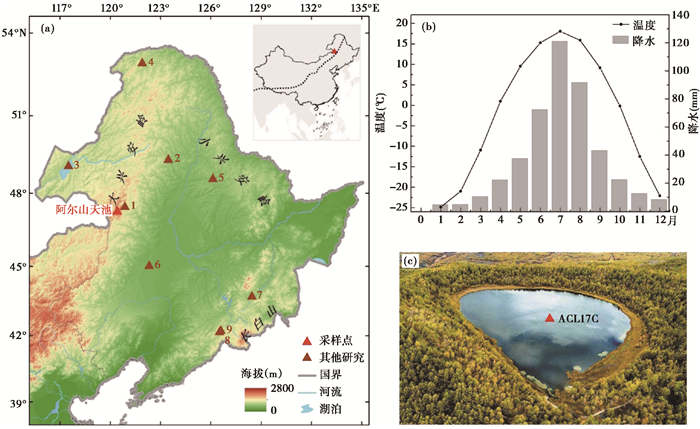
|
图 1 阿尔山天池和其他古气候记录的地理位置(a)、阿尔山现代气象记录(2001~2019年) (b) 及阿尔山天池岩芯ACL17C采样位置(c) 1. 月亮湖[34~35];2. 四方山天池[26, 36];3. 呼伦湖[37];4. 霍拉盆地[28, 38];5. 五大连池[10];6. 向海[21];7. 镜泊湖[39];8. 哈泥泥炭[14];9. 四海龙湾玛珥湖[6] Fig. 1 Location of Arxan Crater Tianchi Lake and other paleoclimate records (a), averaged monthly temperature, precipitation and moisture in Arxan(2001~2019) (b)and sample location of ACL17C (c). 1. Moon Lake[34~35]; 2. Sifangshan Lake[26, 36]; 3. Hulun Lake[37]; 4. Huola basin[28, 38]; 5. Tianchi Lake[10]; 6. Xianghai Lake[21]; 7. Jingpo Lake[39]; 8. Hani peatland[14]; 9. Sihailongwan Maar Lake[6] |
2017年3月,在阿尔山天池湖中心(47.32°N,120.41°E;1280m a.s.l.)水深2.1m处使用加拿大Winke钻获得总长为8.75m的连续湖泊沉积物(ACL17C)。本次研究主要关注岩芯上部约2.5m,根据已发表的AMS14C定年结果(表 1)[23],采用Clam模型中局部加权薄板样条法(Locally Weighted Spline)建立了阿尔山天池钻孔上部涵盖全新世时期的年代深度模型(图 2)。
| 表 1 阿尔山天池湖泊ACL17C沉积物AMS14C测年结果及沉积速率[23] Table 1 Radiocarbon dates and deposition rate of ACL17C from Arxan Crater Tianchi Lake |
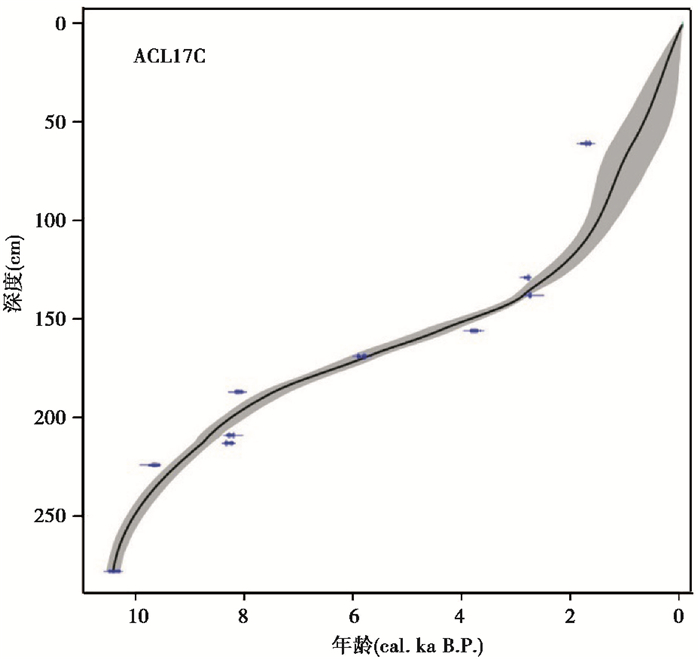
|
图 2 阿尔山天池ACL17C岩芯深度-年代模型[23] Fig. 2 Age-depth model of the sediment core ACL17C from Arxan Crater Tianchi Lake |
对ACL17C岩芯以3~6cm间隔取59个样品,冷冻干燥后,称0.1~1.5g样品于特氟龙瓶中,用10ml二氯甲烷:甲醇(DCM ︰ MeOH=9 ︰ 1)混合溶液萃取3次,提取液在氮气下吹干后加入约3ml 6 % NaOH的甲醇溶液进行皂化,超声15min后静置过夜。向皂化完成的样品中加入1.5ml 5 % NaCl溶液和1.5ml的正己烷,震荡后离心,吸取上层液体至4ml的样品瓶中,重复过程3次,完成后样品瓶放于通风橱中自然风干。取一硅胶柱(柱高约4cm),用二氯甲烷和正己烷分别润洗后,用少量正己烷溶解萃取液并加入硅胶柱中,洗脱烷烃组分于4ml样品瓶中。样品风干后,转移至2ml样品瓶,等待进行气相色谱分析[40~41]。
已完成前处理分析的沉积物样品的非极性组分定容后在Angilent 7890B Gas Chromatography(GC)进行正构烷烃的量化分析。仪器配置为:毛细管柱为DB-1ms型(60m×0.32mm×0.25μm直径),载气为N2,进样口温度为310 ℃,柱流速为1.3ml/min,进样量为1μL。初始温度40℃保留1min,10℃/min升温至150℃,6℃/min升温至310℃保留20min。使用正构烷烃(C21~C33)的混合标准作为外标进行定量[40]。气相色谱分析在中国科学院南京地理与湖泊研究所有机地球化学实验室完成,通过GC仪器测得阿尔山天池湖泊沉积物中的正构烷烃峰面积并积分。
3 结果与讨论 3.1 正构烷烃的分布特征及湖泊有机质来源正构烷烃广泛存在于细菌、藻类、大型水生植物以及高等植物等生物体中[42]。研究表明,来源于陆生高等植物的正构烷烃以长链正构烷烃为主,碳数主要分布在nC27~nC35之间,且以nC27、nC29或nC31为主峰,具有明显的奇碳优势;来源于水生藻类和浮游细菌的段链正构烷烃,碳数主要分布在nC15~nC21之间,且以nC17或nC19为主峰,无明显的奇偶优势;碳数分布在nC23~nC25之间的中链正构烷烃主要来源于大型水生植物[25, 43~44]。阿尔山天池湖泊沉积物中检测到的正构烷烃碳数分布范围为nC17~nC35之间,正构烷烃的分布呈现典型的单峰模式,大部分以中高碳数正构烷烃为主,并以nC27为主峰(图 3)。短链正构烷烃(nC17~nC21)奇偶优势不明显,中链(nC23~nC25)和长链正构烷烃(nC27~nC35)则具有明显的奇碳优势。通过对全新世以来奇碳数正构烷烃相对百分含量沿剖面的变化情况进行统计、分析,结果显示(图 4和5),全新世以来,阿尔山天池湖泊沉积物中不同链长的正构烷烃百分含量差异较大,短链正构烷烃含量较少,且变化趋势较为一致;中链正构烷烃含量介于15 % ~40 % 之间,并呈现减少的趋势;长链正构烷烃含量较多(40 % ~65 %),晚全新世nC27含量减少,nC31~nC35含量呈现明显的增加趋势。
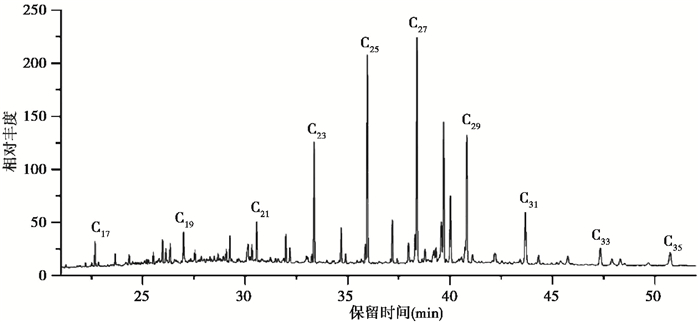
|
图 3 阿尔山天池沉积物代表样品气象色谱图 Fig. 3 Representative gas chromatogram of n-alkanes in the core of Arxan Crater Tianchi Lake |
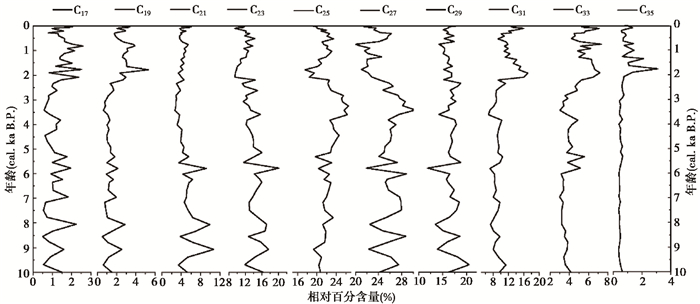
|
图 4 全新世以来阿尔山天池沉积物中不同链长正构烷烃相对百分含量的变化 Fig. 4 Variations of relative percentage content of the n-alkanes in Arxan Crater Tianchi Lake sediment during the Holocene |
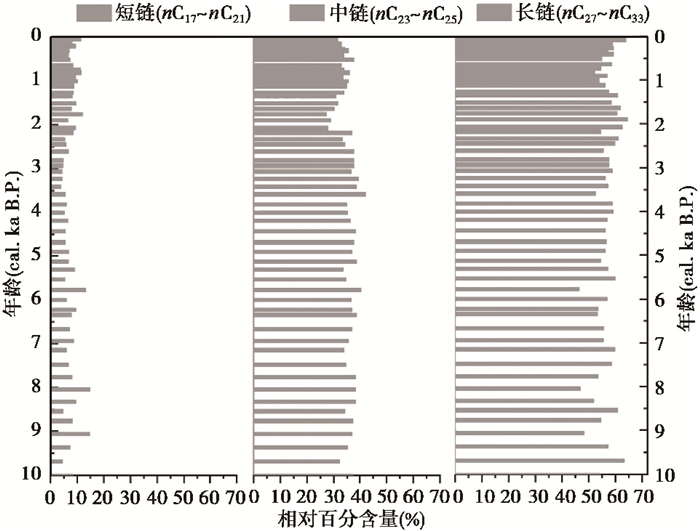
|
图 5 全新世以来阿尔山天池沉积物短链、中链和长链正构烷烃相对百分含量的变化 Fig. 5 Variation of relative percentage contents of the short-chain, mid-chain and long-chain n-alkanes in Arxan Crater Tianchi Lake during the Holocene |
阿尔山天池是一个封闭的火山口湖,湖泊沉积物不会受到来自河流的干扰而得以连续沉积。藻类、水生植物(挺水、浮水和沉水植物)、湖边的陆生植物和微生物是湖泊沉积物中有机质的主要来源[44],不同链长的正构烷烃可以粗略的区分沉积物中有机质的来源。目前阿尔山天池已经进入了湖泊演化的晚期,其湖泊水位较低,沉水和浮水植物繁茂,中链正构烷烃主要来自湖泊中的沉/浮水植物[26];此外,阿尔山天池湖泊流域内陆生植被茂盛,且以C3植物为主,故长链正构烷烃主要来源于集水区内的C3植物及湖泊周围生长的挺水植物和湿生植物,短链正构烷烃则主要来源于藻类和细菌的输入[23, 26, 36]。阿尔山天池湖泊沉积物中正构烷烃碳数分布特征(图 3和4)和短链、中链和长链正构烷烃百分含量(图 5)的变化说明在气候演化的不同阶段,陆生植物和水生植物对沉积物中有机质的贡献比例较大,因此有机质主要来源于陆生植物和水生植物的共同输入,并以陆生植物的贡献占主导,结果和大兴安岭北段同为火山口湖的四方山天池的结果较为一致[26]。
3.2 正构烷烃记录的全新世以来的植被与气候演变利用正构烷烃重建湖泊演化的植被和气候变化规律,通常会用到正构烷烃的浓度[40]、Paq[45~46]、ACL27~33[4]、C27/C31[47~48]等相关的指标来反映古环境变化。正构烷烃的浓度一定程度上能反映有机质含量的变化,进而反映湖泊与流域的生产力[40];Paq值用于区分陆源高等植物、挺水植物、沉水/漂浮植物对湖泊沉积物中正构烷烃的贡献比例,也用来评估湖泊水位的变化[26]。Paq越低,表示陆生高等植物或挺水植物贡献越大,气候相对干燥,湖泊水面收缩,水位下降,反之则沉水和漂浮植物贡献较高,水位上升[4, 46];ACL27~33(平均碳链长度)为长链正构烷烃的平均链长,研究表明,陆生植被中木本植物所占比例增加时,ACL27~33值降低;陆生植被中草本植物比例增加时ACL27~33值升高[49]。另外,草本植物占优势时,nC31为主峰碳;木本植物占优势时,nC27或nC29为主峰碳,因此正构烷烃ACL27~33和nC27/nC31比值均可反映草本和木本植物相对丰度变化,其比值增加,草本植物向木本植物演化;比值减小,木本植物向草本植物过渡[21, 50]。代用指标结果如图 6c、6d、6e和6f所示。
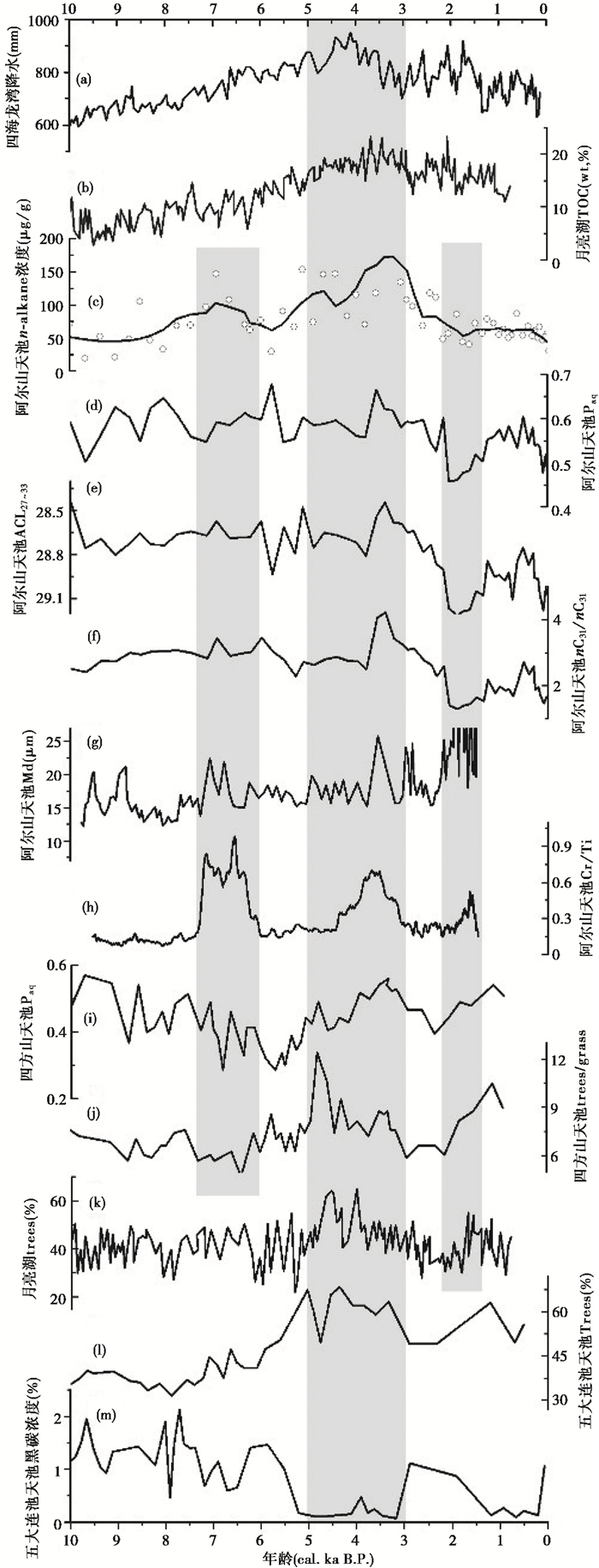
|
图 6 阿尔山天池全新世气候代用指标变化特征及其与其他气候/植被记录的对比 (a)四海龙湾孢粉定量重建的降水记录[6];(b)大兴安岭中部月亮湖总有机碳记录[34];本研究阿尔山天池正构烷烃指标,如(c)浓度、(d)Paq、(e)ACL27~33和(f)nC27/nC33;(g)阿尔山天池粒度指标[23];(h)阿尔山天池Cr/Ti指标[23];(i)大兴安岭中北部四方山天池Paq记录[26];(j)四方山天池木本/草本记录[26];(k)月亮湖木本花粉百分含量[34];(l)小兴安岭五大连池木本花粉百分含量记录[10];(m)五大连池黑碳浓度[19]阴影部分为文中讨论所涉及的不同气候变化阶段 Fig. 6 Comparison of the climate proxies in Arxan Crater Lake with other climate/vegetation records during the Holocene. (a)Quantitative reconstructed precipitation in SHL[6]; (b)TOC from Moon Lake[34]; Alkane concentration (c), Paq (d), ACL27~33 (e), and nC27/nC31 (f)proxies in Arxan Crater Lake(this study); (g)Mean grain size in Arxan Crater Lake[23]; (h)Lake levels(Cr/Ti)indicators from Arxan Crater Lake[23]; Paq[26](i) and trees/grass[26](j) proxies from Sifangshan Lake in Great Khingan Mountains; (k)Tree pollen from Moon Lake[34]; (l)Tree pollen from Tianchi Lake[10]; (m)Black Carbon(BC) concentration from Tianchi Lake[19]. The shaded sections are for the different stages of climate change discussed in the paper |
早全新世期间,阿尔山天池湖泊沉积物中正构烷烃浓度相对较低并呈现增加的趋势,说明湖泊与流域的初始生产力较低,随着早全新世气候的变暖,有机质输入增多。阿尔山天池附近月亮湖的TOC结果[34](图 6b)也表明在早全新世期间沉积物中的有机质含量较少,并呈现逐渐上升的趋势。C27/C31和ACL27~33指示木本植物的输入比例增加,草本植物的输入比例较少。Paq值波动明显,指示湖泊水位变化频繁。四海龙湾孢粉定量重建的降水结果[6](图 6a)也表明早全新世期间降水量呈现逐渐上升的趋势。
中全新世期间,阿尔山天池正构烷烃浓度较高,指示湖泊与流域的初始生产力升高,有机质输入较多;Paq值相对较高,指示湖泊水位较高;ACL27~33和nC27/nC31比值指示湖泊有机质输入多为木本植物。值得注意的是,在7.5~6.0cal. ka B.P. 期间,正构烷烃浓度明显升高,Paq值有小幅度的下降,指示陆生高等植物和挺水植物贡献增大。附近的四方山天池Paq值(图 6i)[26]波动下降,也表明水生植物对湖泊沉积物中的有机质贡献比例降低。但是崔巧玉和赵艳[23]对阿尔山天池剖面进行元素测试的结果显示在该阶段Sr、Rb、Zr、Fe等元素的变化出现低值区,而元素Cr与其他元素变化趋势相反,Cr是重金属元素,会受到湖泊水体酸化和氧化还原条件,Cr/Ti的高值(图 6h)可以推测湖泊水位升高,湖面扩张,由于本阶段平均粒径较粗(图 6g),推测可能由于降水的增多,大量陆生植物冲积入湖,湖泊水位上升。
在5.0~3.0cal. ka B.P. 期间,短链正构烷烃含量减少,指示藻类输入减少;长链正构烷烃增加,陆生植物输入增多,正构烷烃浓度在该阶段达到了整个剖面的最高值,推测湖盆周围高等陆生植物生长较为茂盛,湖泊中有机质含量较高,湖泊与流域的生产力较强。该阶段Paq相对较高,陆生高等植物和挺水植物贡献较小,湖泊水位较高。但是也由于植被状况较好,雨水冲刷作用较弱,入湖矿物质较少,沉积速率较慢。阿尔山天池元素结果[32]表明,在5.0~3.0cal. ka B.P. 期间,Cr/Ti比值增大,再次达到全剖面的极值,指示湖泊水位较高,气候较为温暖湿润。附近月亮湖[34]的孢粉结果表明5.0cal. ka B.P. 之后,木本孢粉含量增加,TOC、TN、C/N均呈现上升的趋势,期间达到整个沉积序列的最高值(图 6k),δ13Corg值相对偏负,与TOC和TN的增加相对应,可能反映了气候变得更适宜(有效湿度增加),陆生植物的生长更加茂盛。大兴安岭中北段的四方山天池的正构烷烃和单体碳同位素结果表明,在6.4~3.4cal. ka B.P. 期间,区域有效湿度较高,陆生C3植物中木本植物扩张,湖泊水位上升,湖泊初级生产力增大,气候较为稳定[26, 36](图 6i和6j)。小兴安岭中段五大连池的孢粉记录(图 6l)和有机指标[10, 18, 42]指示早、中全新世降水呈现逐渐增加的趋势,5.5~3.1cal. ka B.P. 期间气候较为适宜,且黑碳结果表明该阶段小兴安岭地区发生火灾的频率很低(图 6m),与该阶段气候较为湿润有关[19]。Zhang等[7]对东北地区的降水综述结果认为,全新世期间东北不同区域降水的最高值不同,在东北的中部和北部,中晚全新世的降水较高,但是东北地区东部的早中全新世的降水量较高。阿尔山天池和附近的研究结果均表明[8, 13, 18],大小兴安岭地区的降水多集中于在中晚全新世,植被较为茂盛,气候较适宜,说明东北地区由于受到不同区域不同气候系统的影响,导致不同地区的全新世适宜期出现了差异,推测由于东亚季风、东北季风和西风的共同影响导致东北地区的全新世适宜期不同,有待更进一步深入的研究。
3.0cal. ka B.P. 以来,阿尔山天池沉积物正构烷烃浓度下降,入湖有机质减少,与月亮湖TOC变化一致[34]。短链正构烷烃含量增多,藻类输入增多,湖泊和流域的生产力下降。ACL27~33和nC27/nC31比值结果显示本阶段草本植物在整个剖面中输入较高,指示木本植被收缩,月亮湖[34]孢粉结果也显示本阶段木本植被减少,湖泊有机质输入减少,湖泊水位降低。在2.3~1.5cal. ka B.P. 期间,长链和短链正构烷烃含量增加,指示陆生植物和藻类的大量输入。在该阶段Paq结果达到了剖面的最小值,指示该阶段湖泊水位很低。ACL27~33和nC27/nC31比值指示湖泊有机质输入多为草本植物。在此期间,阿尔山天池元素结果[23]表明,Cr/Ti再次出现一个偏小的峰值,沉积物粒径较粗,大量粗颗粒的陆源物质冲积入湖(图 6g和6h)。月亮湖、霍拉盆地和镜泊湖等地研究结果均反映了2.3~1.5cal. ka B.P. 左右的气温突降和降水减少事件[34, 38, 51],因此推测在该阶段东北地区发生了区域性的突然冷干事件。在1.5~0.8cal. ka B.P. 期间,短链正构烷烃开始减少,中、长链正构烷烃含量增加,指示藻类的输入减少,水生和陆生高等植物的输入增加。Paq值较高,指示湖泊水位较上一阶段明显升高。0.8cal. ka B.P. 至今,湖泊水位相对较低,沉积速率较快,正构烷烃浓度持续减少,草本输入增加,木本输入减少,湖泊逐渐退化。
4 结论本文通过对阿尔山天池湖泊沉积物进行正构烷烃分析发现:全新世期间,阿尔山天池正构烷烃呈单峰型分布特征,正构烷烃碳数分布范围为nC17~nC35,主峰碳为nC27,藻类、沉水/漂浮植物和陆生高等植物输入变化较大,但总体上湖泊有机质输入来源于陆生高等植物和沉水/漂浮植物的共同输入。正构烷烃各代用指标记录了全新世以来阿尔山天池湖泊环境的变迁及区域气候的演化历史:全新世早期,湖泊与流域初始生产力较低,随着气候逐渐转暖湿,湖泊水位升高,湖泊生产力逐渐增强。在5.0~3.0cal. ka B.P. 期间,湖泊中陆生植物输入增多,藻类输入减少,正构烷烃浓度最大,湖泊生产力较强,湖泊水位较高,植被状况达到全新世期间最繁盛状态,为气候最适宜的时期。3.0 cal. ka B.P. 之后其发生了多次波动,较不稳定,湖泊水位降低,藻类和水生植物输入明显增加,陆生高等植物减少。另外在7.5~6.0cal. ka B.P. 期间,水位突然升高,陆生植物大量输入;在2.3~1.5cal. ka B.P. 左右,湖泊水位大幅度降低,藻类大量繁殖,推测为区域的气候突然冷干事件。结合阿尔山天池和附近研究的植被状况及气候演化结果表明大小兴安岭地区中晚全新世期间植被生长茂盛,湖泊水位高,气候较为温暖湿润,为全新世最适宜期。
致谢: 感谢伍婧、任维鹤协助野外钻探;感谢周爱锋老师在分样过程中的帮助。
| [1] |
Zhang S, Xiao J, Xu Q, et al. Contrasting impacts of the 8.2- and 4.2-ka abrupt climatic events on the regional vegetation of the Hulun Lake region in north-eastern China[J]. Journal of Quaternary Science, 2020, 35(6): 1-10. |
| [2] |
Chen F, Wu D, Chen J, et al. Holocene moisture and East Asian summer monsoon evolution in the northeastern Tibetan Plateau recorded by Lake Qinghai and its environs: A review of conflicting proxies[J]. Quaternary Science Reviews, 2016, 154: 111-129. DOI:10.1016/j.quascirev.2016.10.021 |
| [3] |
Chen F, Xu Q, Chen J, et al. East Asian summer monsoon precipitation variability since the last deglaciation[J]. Scientific Reports, 2015, 5(1): 1-11. DOI:10.9734/JSRR/2015/14076 |
| [4] |
Zhou W, Zheng Y, Meyers P A, et al. Postglacial climate-change record in biomarker lipid compositions of the Hani peat sequence, Northeastern China[J]. Earth and Planetary Science Letters, 2010, 294(1-2): 37-46. DOI:10.1016/j.epsl.2010.02.035 |
| [5] |
An Z, Porter S C, Kutzbach J E, et al. Asynchronous Holocene optimum of the East Asian monsoon[J]. Quaternary Science Reviews, 2000, 19(8): 743-762. DOI:10.1016/S0277-3791(99)00031-1 |
| [6] |
Stebich M, Rehfeld K, Schlütz F, et al. Holocene vegetation and climate dynamics of NE China based on the pollen record from Sihailongwan Maar Lake[J]. Quaternary Science Reviews, 2015, 124: 275-289. DOI:10.1016/j.quascirev.2015.07.021 |
| [7] |
Zhang M, Bu Z, Wang S, et al. Moisture changes in Northeast China since the last deglaciation: Spatiotemporal out-of-phase patterns and possible forcing mechanisms[J]. Earth-Science Reviews, 2020, 201: 1-24. DOI:10.1016/j.earscirev.2019.102984 |
| [8] |
Zhao Y, Yu Z, Chen F, et al. Vegetation response to Holocene climate change in monsoon-influenced region of China[J]. Earth-Science Reviews, 2009, 97(1-4): 242-256. DOI:10.1016/j.earscirev.2009.10.007 |
| [9] |
Zheng Y, Pancost R D, Liu X, et al. Atmospheric connections with the North Atlantic enhanced the deglacial warming in Northeast China[J]. Geology, 2017, 45(11): 1031-1034. DOI:10.1130/G39401.1 |
| [10] |
Zhou X, Sun L, Zhan T, et al. Time-transgressive onset of the Holocene Optimum in the East Asian monsoon region[J]. Earth and Planetary Science Letters, 2016, 456: 39-46. DOI:10.1016/j.epsl.2016.09.052 |
| [11] |
施雅风, 孔昭宸, 王苏民, 等. 中国全新世大暖期鼎盛阶段的气候与环境[J]. 中国科学(B辑), 1993, 29(8): 865-873. Shi Yafeng, Kong Zhaochen, Wang Sumin, et al. Basic feature of climate and environment during the Holocene Megathemal in China[J]. Science in China(Series B), 1993, 29(8): 865-873. |
| [12] |
Zheng Y, Pancost R D, Naafs B D A, et al. Transition from a warm and dry to a cold and wet climate in NE China across the Holocene[J]. Earth and Planetary Science Letters, 2018, 493: 36-46. DOI:10.1016/j.epsl.2018.04.019 |
| [13] |
Chen J, Rao Z, Liu J, et al. On the timing of the East Asian summer monsoon maximum during the Holocene-Does the speleothem oxygen isotope record reflect monsoon rainfall variability?[J]. Science China: Earth Sciences, 2016, 59(12): 2328-2338. DOI:10.1007/s11430-015-5500-5 |
| [14] |
喻春霞, 罗运利, 孙湘君. 吉林柳河哈尼湖13.1-4.5 cal. ka B. P. 古气候演化的高分辨率孢粉记录[J]. 第四纪研究, 2008, 28(5): 929-938. Yu Chunxia, Luo Yunli, Sun Xiangjun. A high-resolotion pollen records from Hani Lake, Jilin, Northeast China showing climate changes between 13.1-4.5 cal. ka B. P.[J]. Quaternary Sciences, 2008, 28(5): 929-938. DOI:10.3321/j.issn:1001-7410.2008.05.016 |
| [15] |
Li N, Chambers F M, Yang J, et al. Records of East Asian monsoon activities in Northeastern China since 15.6 ka, based on grain size analysis of peaty sediments in the Changbai Mountains[J]. Quaternary International, 2017, 447: 158-169. DOI:10.1016/j.quaint.2017.03.064 |
| [16] |
洪冰, 刘丛强, 林庆华, 等. 哈尼泥炭δ18O记录的过去14000年温度演变[J]. 中国科学(D辑: 地球科学), 2009, 39(5): 626-637. Hong Bing, Liu Congqiang, Lin Qinghua, et al. Temperature evolution from the δ18O record from Hani peat, Northeast China, in the last 14000 years[J]. Science in China (Series D: Earth Sciences), 2009, 39(5): 626-637. |
| [17] |
Chu G, Sun Q, Xie M, et al. Holocene cyclic climatic variations and the role of the Pacific Ocean as recorded in varved sediments from Northeastern China[J]. Quaternary Science Reviews, 2014, 102: 85-95. DOI:10.1016/j.quascirev.2014.08.008 |
| [18] |
Liu X, Zhan T, Zhou X, et al. Late onset of the Holocene rainfall maximum in Northeastern China inferred from a pollen record from the sediments of Tianchi Crater Lake[J]. Quaternary Research, 2019, 92(1): 133-145. DOI:10.1017/qua.2018.137 |
| [19] |
Pang Y, Zhou B, Zhou X, et al. Abundance and δ13C of sedimentary black carbon indicate rising wildfire and C4 plants in Northeast China during the Early Holocene[J]. Palaeogeography, Palaeoclimatology, Palaeoecology, 2021, 562: 1-8. DOI:10.1016/j.palaeo.2020.110075 |
| [20] |
沈吉. 末次盛冰期以来中国湖泊时空演变及驱动机制研究综述: 来自湖泊沉积的证据[J]. 科学通报, 2012, 57(34): 3228-3242. Shen Ji. Spatiotemporal variations of Chinese lakes and their driving mechanisms since the Last Glacial Maximum: A review and synthesis of lacustrine sediment archives[J]. Chinese Science Bulletin, 2012, 57(34): 3228-3242. |
| [21] |
孟培, 王永莉, 王自翔, 等. 东北地区向海湖泊沉积物正构烷烃单体碳同位素特征及其古环境意义[J]. 地球科学与环境学报, 2014, 36(2): 110-120. Meng Pei, Wang Yongli, Wang Zixiang, et al. Compound-specific carbon isotopic characteristics of n-alkanes in Xianghai Lake sediments of Northeast China and their paleoenvironmental implications[J]. Journal of Earth Sciences and Environment, 2014, 36(2): 110-120. DOI:10.3969/j.issn.1672-6561.2014.02.016 |
| [22] |
沈吉. 湖泊沉积研究的历史进展与展望[J]. 湖泊科学, 2009, 21(3): 307-313. Shen Ji. Progress and prospect of palaeolimnology research in China[J]. Journal of Lake Sciences, 2009, 21(3): 307-313. DOI:10.3321/j.issn:1003-5427.2009.03.001 |
| [23] |
崔巧玉, 赵艳. 大兴安岭阿尔山天池湖泊沉积物记录的全新世气候突变[J]. 第四纪研究, 2019, 39(6): 1346-1356. Cui Qiaoyu, Zhao Yan. Climatic abrupt events implied by lacustrine sediments of Arxan Crater Lake, in the central Great Khingan Mountains, NE China during Holocene[J]. Quaternary Sciences, 2019, 39(6): 1346-1356. |
| [24] |
孙晓双, 张灿, 柴轶凡, 等. 云南高海拔湖泊对末次冰消期气候突变的响应[J]. 第四纪研究, 2019, 39(4): 975-984. Sun Xiaoshuang, Zhang Can, Chai Yifan, et al. High-altitude lake sediments in response to abrupt climatic events during the last deglaciation in Southwestern China[J]. Quaternary Sciences, 2019, 39(4): 975-984. |
| [25] |
Meyers P A. Organic geochemical proxies of paleoceanographic, paleolimnologic, and paleoclimatic processes[J]. Organic Geochemistry, 1997, 27(5): 213-250. |
| [26] |
刘嘉丽, 刘强, 伍婧, 等. 大兴安岭四方山天池全新世以来沉积物正构烷烃分布、单体碳同位素特征及古环境意义[J]. 湖泊科学, 2017, 29(2): 498-511. Liu Jiali, Liu Qiang, Wu Jing, et al. N-alkanes distributions and compound-specific carbon isotope records and their paleoenviromental significance of sediments from Lake Sifangshan in the Great Khingan Mountain, Northeastern China[J]. Journal of Lake Sciences, 2017, 29(2): 498-511. |
| [27] |
Yamamoto S, Kawamura K, Seki O, et al. Environmental influences over the last 16 ka on compound-specific δ13C variations of leaf wax n-alkanes in the Hani peat deposit from Northeast China[J]. Chemical Geology, 2010, 277(3-4): 261-268. DOI:10.1016/j.chemgeo.2010.08.009 |
| [28] |
马雪云, 魏志福, 王永莉, 等. 末次冰盛期以来东北地区霍拉盆地湖泊沉积物记录的C3/C4植被演化[J]. 第四纪研究, 2018, 38(5): 1193-1202. Ma Xueyun, Wei Zifu, Wang Yongli, et al. C3/C4 vegetation evolution recorded by lake sediments in the Huola basin, Northeast China since the Last Glacial Maximum[J]. Quaternary Sciences, 2018, 38(5): 1193-1202. |
| [29] |
赵勇伟. 大兴安岭第四纪火山地质与地球化学研究[J]. 国际地震动态, 2011(8): 37-42. Zhao Yongwei. Study on geology and geochemistry of Quaternary volcanoes in the Da Hinggan Ling Mountains[J]. Recent Developments in World Seismology, 2011(8): 37-42. DOI:10.3969/j.issn.0235-4975.2011.08.007 |
| [30] |
刘嘉麒. 中国东北地区新生代火山岩的年代学研究[J]. 岩石学报, 1987, 4: 21-31. Liu Jiaqi. Study on geochronology of the Cenozoic volcanic rocks in Northeast China[J]. Acta Petrologica Sinica, 1987, 4: 21-31. DOI:10.3321/j.issn:1000-0569.1987.04.003 |
| [31] |
赵勇伟, 樊祺诚, 白志达, 等. 大兴安岭哈拉哈河-淖尔河地区第四纪火山活动初步研究[J]. 岩石学报, 2008, 24(11): 2569-2575. Zhao Yongwei, Fan Qicheng, Bai Zhida, et al. Preliminary study on Quaternary volcanoes in the Halaha River and Chaoer River area in Daxing'an Mountain range[J]. Acta Petrologica Sinica, 2008, 24(11): 2569-2575. |
| [32] |
马雨轩, 李江海, 陈耀华. 大兴安岭中段阿尔山地区第四纪火山地貌特征及其构造意义[J]. 北京大学学报(自然科学版), 2019, 55(02): 289-298. Ma Yuxuan, Li Jianghai, Chen Yaohua. Geomorphological characteristics of the Quaternary volcanoes and their tectonic implications in Aershan Region, Central Greater Khingan Range[J]. Acta Scientiarum Naturalium Universitatis Pekinensis, 2019, 55(2): 289-298. |
| [33] |
李雪林. 内蒙古阿尔山天池小冰期以来湖泊钻孔孢粉特征及植被演替[D]. 北京: 中国地质大学(北京)硕士学位论文, 2012: 1-65. Li Xuelin. Inner Mongolia the Aer Tianchi since the Little Ice Age Lake Drilling Pollen Characteristics and Vegetation Succession[D]. Beijing: The Master's Dissertation of China University of Geosciences(Beijing), 2012: 1-65. |
| [34] |
刘强, 李倩, 旺罗, 等. 21 ka B. P. 以来大兴安岭中段月亮湖沉积物全岩有机碳同位素组成变化及其古气候意义[J]. 第四纪研究, 2010, 30(6): 1069-1077. Liu Qiang, Li Qian, Wang Luo, et al. Stable carbon isotope record of bulk organic matter from a sediment core at Moon Lake in the middle part of the Daxing'an Mountain range, Northeast China during the last 21 ka B. P.[J]. Quaternary Sciences, 2010, 30(6): 1069-1077. DOI:10.3969/j.issn.1001-7410.2010.06.01 |
| [35] |
伍婧, 刘强. 晚冰期以来月亮湖孢粉记录反映的古植被与古气候演化[J]. 地球科学——中国地质大学学报, 2012, 37(5): 947-954. Wu Jing, Liu Qiang. Pollen-record vegetation and climate changes from Moon Lake since Late Glacial[J]. Earth Science-Journal of China University of Geosciences, 2012, 37(5): 947-954. |
| [36] |
刘嘉丽, 刘强, 储国强, 等. 大兴安岭四方山天池15.4 ka B. P. 以来湖泊沉积记录[J]. 第四纪研究, 2015, 35(4): 901-912. Liu Jiali, Liu Qiang, Chu Guoqiang, et al. Sediment record at Lake Sifangshan in the central-northern part of the Great Xing'an Range, Northeast China since 15.4 ka B. P.[J]. Quaternary Sciences, 2015, 35(4): 901-912. |
| [37] |
Wen R, Xiao J, Chang Z, et al. Holocene precipitation and temperature variations in the East Asian monsoonal margin from pollen data from Hulun Lake in northeastern Inner Mongolia, China[J]. Boreas, 2010, 39(2): 262-272. DOI:10.1111/j.1502-3885.2009.00125.x |
| [38] |
Zhao C, Li X, Zhou X, et al. Holocene vegetation succession and responses to climate change in the northern sector of Northeast China[J]. Science China: Earth Sciences, 2016, 59(7): 1390-1400. DOI:10.1007/s11430-015-5239-7 |
| [39] |
Chen R, Shen J, Li C, et al. Mid-to Late-Holocene East Asian summer monsoon variability recorded in lacustrine sediments from Jingpo Lake, Northeastern China[J]. The Holocene, 2015, 25(3): 454-468. DOI:10.1177/0959683614561888 |
| [40] |
Zhang C, Zhao C, Zhou A, et al. Late Holocene lacustrine environmental and ecological changes caused by anthropogenic activities in the Chinese Loess Plateau[J]. Quaternary Science Reviews, 2019, 203: 266-277. DOI:10.1016/j.quascirev.2018.11.020 |
| [41] |
柴轶凡, 张灿, 孔令阳, 等. 云南错恰湖两百年来气候环境变化与重金属污染[J]. 湖泊科学, 2018, 30(6): 1732-1744. Chai Yifan, Zhang Can, Kong Lingyang, et al. Climatic changes and heavy metal pollution over the past 200 years recorded by Lake Cuoqia, Southwestern Yunnan Province[J]. Journal of Lake Sciences, 2018, 30(6): 1732-1744. |
| [42] |
汪亘, 王永莉, 孟培, 等. 东北地区五大连池湖相沉积物正构烷烃和单体碳同位素特征及其古植被意义[J]. 第四纪研究, 2015, 35(4): 890-900. Wang Gen, Wang Yongli, Meng Pei, et al. Chemical and compound-specific carbon isotopic characteristics of n-alkane in the Qingshi Lacustrine sediments, Wudalianchi, Northeast China, and their paleovegetation significances[J]. Quaternary Sciences, 2015, 35(4): 890-900. |
| [43] |
崔琳琳, 王旭, 沈吉, 等. 末次盛冰期以来泸沽湖沉积记录的正构烷烃分布特征和单体碳同位素组成及其古植被意义[J]. 第四纪研究, 2015, 35(4): 871-880. Cui Linlin, Wang Xu, Shen Ji, et al. Changes in distribution and compound-specific carbon isotope compositions of n-alkanes as recorded in Lugu Lake sediments from Southwestern China since Last Glacial Maximum and implications for paleovegetation evolution[J]. Quaternary Sciences, 2015, 35(4): 871-880. |
| [44] |
Da Silva L S V, Piovano E L, Azevedo D D A, et al. Quantitative evaluation of sedimentary organic matter from Laguna Mar Chiquita, Argentina[J]. Organic Geochemistry, 2008, 39(4): 450-464. DOI:10.1016/j.orggeochem.2008.01.002 |
| [45] |
Ficken K J, Li B, Swain D L, et al. An n-alkane proxy for the sedimentary input of submerged/floating freshwater aquatic macrophytes[J]. Organic Geochemistry, 2000, 31(7-8): 745-749. DOI:10.1016/S0146-6380(00)00081-4 |
| [46] |
Seki O, Meyers P A, Kawamura K, et al. Hydrogen isotopic ratios of plant wax n-alkanes in a peat bog deposited in Northeast China during the last 16 kyr[J]. Organic Geochemistry, 2009, 40(6): 671-677. DOI:10.1016/j.orggeochem.2009.03.007 |
| [47] |
饶志国, 贾国东, 朱照宇, 等. 中国东部表土总有机质碳同位素和长链正构烷烃碳同位素对比研究及其意义[J]. 科学通报, 2008, 53(17): 2077-2084. Rao Zhiguo, Jia Guodong, Zhu Zhaoyu, et al. Comparative study on carbon isotope and long-chain normal paraffin carbon isotope of total organic matter in topsoil of Eastern China and its significance[J]. Chinese Science Bulletin, 2008, 53(17): 2077-2084. DOI:10.3321/j.issn:0023-074X.2008.17.013 |
| [48] |
Marzi R, Torkelson B E, Olson R K. A revised carbon preference index[J]. Organic Geochemistry, 1993, 8(20): 1303-1306. |
| [49] |
Bendle J, Kawamura K, Yamazaki K, et al. Latitudinal distribution of terrestrial lipid biomarkers and n-alkane compound-specific stable carbon isotope ratios in the atmosphere over the western Pacific and Southern Ocean[J]. Geochimica et Cosmochimica Acta, 2007, 71(24): 5934-5955. DOI:10.1016/j.gca.2007.09.029 |
| [50] |
何薇, 汪亘, 王永莉, 等. 四川邛海湖泊沉积物记录的过去30 cal. ka B. P. 以来的古气候环境特征[J]. 第四纪研究, 2018, 38(5): 1179-1192. He Wei, Wang Gen, Wang Yongli, et al. Characteristics of climate and environment over the past 30 cal. ka B. P. recorded in lacustrine deposits of the Qionghai Lake, Sichuan Province[J]. Quaternary Sciences, 2018, 38(5): 1179-1192. |
| [51] |
Li C, Wu Y, Hou X. Holocene vegetation and climate in Northeast China revealed from Jingbo Lake sediment[J]. Quaternary International, 2011, 229(1-2): 67-73. DOI:10.1016/j.quaint.2009.12.015 |
2 University of Chinese Academy of Sciences, Beijing 100049;
3 Key Laboratory of Land Surface Pattern and Simulation, Institute of Geographical Sciences and Natural Resources Research, Chinese Academy of Sciences, Beijing 100101)
Abstract
Arxan Crater Lake(ACL17C: 47.32°N, 120.41°E; 1280m a. s. l.) is one of the closed volcanic crater lakes at the Arxan-Chaihe volcanic field in the middle of Great Khingan Mountains, NE China, which is located at the northern margin of the East Asian monsoon. A 2.5m sequence lake sediments of ACL17C was sampled at 3~6cm intervals from the bottom to the top. The chronological sequence was determined by AMS14C dating, and the age-depth model was established by Locally Weighted Spline method in the CLAM model which covered the whole Holocene. Here, we present n-alkane analysis on ACL17C to research the lake evolution process and climate change during the Holocene. The distribution of n-alkanes showed the following characteristics: a homologous series of n-alkanes was detected with carbon numbers ranging from nC17 to nC35, most samples show a single peak and the main peak is nC27; The short chain(< nC21) n-alkanes do not have obvious carbon number characteristics. The middle(nC23~nC25) and long(>nC27) chain n-alkanes have an odd over even carbon number predominance. These characteristics show that the organic matter in the lake came from both terrestrial and aquatic plant. Based on the result of n-alkane and above proxy indicators, the changes of lake environment and the evolution history of regional climate in Arxan Tianchi Lake during the Holocene as following: during the Early Holocene, the initial productivity of the lake and area were low, and the productivity of the lake gradually increased with the gradual warming and humidity of the climate and the rise of the lake water level. During the period of 5.0~3.0cal. ka B.P., the input of algae decreased, the input of terrestrial plants increased, the concentration of n-alkane reached the maximum, the productivity of the lake and area was more, the lake water level was high and stable, and the vegetation reached the most prosperous period, which was the most optimum period for the climate. Since 3.0cal. ka B.P., the water level decreased, the input of algae and herbs increased significantly. The climate was relatively unstable. In addition, during the period of 7.5~6.0cal. ka B.P., the water level rose suddenly, and a large number of terrestrial plants were imported. During 2.3~1.5cal. ka B.P., the water level dropped significantly and algae blooms proliferated, presumably as a result of a dry event of the region climate. Combined with the vegetation change and climate evolution of the in Arxan Tianchi Lake and nearby areas, the results show that the Middle-Late Holocene was the optimum period during the Holocene in Great Khingan Mountains, rather than Early-Middle Holocene. 2021, Vol.41
2021, Vol.41

